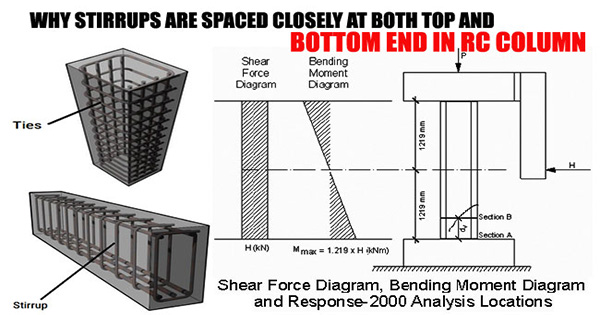Why Stirrups are spaced closely at both top and bottom end in RC Column

This civil engineering article provides the detail about less spacing at both top and bottom end of RC column and beam.
Measurement for spacing of ties is done with adherence to the plastic moment volume of the column. Owing to strength of slab as well as loads produced through earthquake, moments prevail upon column.
Therefore, the moments are higher at the ends of columns and beams. So, there should be adequate spacing at the ends so that no cracking occurs at the end zones.
Normally, bending remains zero at the center of the column. To get rid of spalling of concrete, greater confinement should be arranged at the ends for superior ductility and performance.
Spalling happens due to water penetration that enters into the structures of buildings and results in surface peeling or flaking because of moisture content in the concrete.
For detailing of structure in normal way, it is not necessary to provide tighter spacing of columns adjacent to the supports.
On the other hand, at the time of detailing structures for cyclic loading like earthquake loading, confinement zones are settled in beams and columns.
Due to nonexistence of perfect confinement in beam column joints and column foundation joints, the structures collapse.
The spacing is reduced at the ends of columns and beam of the structures for the following reasons:-
The joint of each column is susceptible to failure because missing of confinement reinforcement. That is way, more confinement reinforcement should be included in each joint. Therefore, the spacing of stirrups is less at the end in spite of middle.
The column has to withstand lateral distributed load caused by wind and earthquake load and for this reason, extreme shear magnitude occurs in the joint of each column. So, the spacing of stirrups is less near the joints of column.
The regions susceptible to seismic force, the spacing should be less at the ends of the columns since shear is extreme in column ends normally and zero in the center. For this purpose, the stirrup is designed to withstand shear loads and the spacing is reduced where shear force is high.
The rings which are utilized in beams known as ties instead of calling it stirrups. But in columns, they are known as stirrups.

